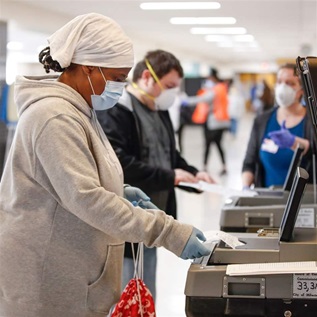Election Websites: Alabama

Researchers assessed state election websites for the Pew Center on the States between May-November 2010, using detailed criteria evaluating the content, lookup tools, and usability. Websites may have changed since they were assessed. See methodology (PDF).
Strengths include:
- Easy-to-find and easy-to-use voting information lookup tools that allow users to learn their registration status, polling place location, and status of absentee and provisional ballots.
- Polling place locator based on street address, allowing users to find this information regardless of their registration status.
- A comprehensive section of information for military and overseas voters—one of the best in the nation—that includes details about the Federal Write-in Absentee Ballot.
- A clean, well-designed home page on the voter-geared website that clearly distinguishes information intended for different audiences, using prominent links for key voter content.
Recommended improvements include:
- Offer a lookup tool for voters to see their sample ballot (22 states offer).
- Provide information on how to complete a ballot (38 states offer), how to obtain a replacement for a lost or damaged absentee ballot (18 offer), and whether absentee voters can get help with marking ballots (18 offer).
- Create a section geared toward voters with disabilities (36 states offer) that provides instruction on how to use special voting machines, the availability of poll worker assistance, and TDD or TTY access.
- Enhance accessibility for users with visual disabilities, including scalable fonts so they can easily change the site's text size, and offer text as an alternative to graphics for users who cannot see images on a website.
- Provide full texts (34 states offer), summaries (39 offer), and nonpartisan analyses (24 offer) for statewide ballot measures.
- Offer information in languages other than English (37 states offer).
- Provide candidate contact information, including street address (44 states offer), e-mail (19 offer), website (20 offer), and telephone number (23 offer).
- Improve navigation on the “Alabama Votes” website by matching link names with page titles so that they are consistent, and provide “breadcrumbs” to help users determine where they are on the website.
- Offer “Voter Guide” content in HTML instead of solely in PDF, which is not easily searchable and inhibits navigation.
- Make clearer explanations of deadlines and the difference between regular and emergency absentee ballot forms.
Noteworthy Feature: Alabama provides e-mail notification of upcoming elections.
Initial Quick Fix: Link to the Federal Election Commission database of campaign finance reports for congressional candidates (37 states offer).
Summary: Alabama provides users with four out of five recommended lookup tools, but its websites have below-average usability and lack important voting information content, resulting in an overall lower score.
www.alabamavotes.gov and www.sos.state.al.us/Elections/Default.aspx were assessed for content and lookup tools.
www.alabamavotes.gov was assessed for usability.











